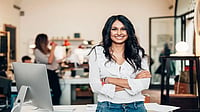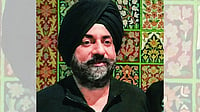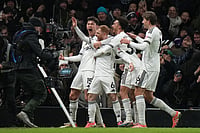When the Ram Janmabhoomi movement was at its peak in 1991, the then P.V. Narasimha Rao-led government brought in the Places of Worship (Special Provisions) Act to defuse the simmering communal tension in the country. The law disallowed any change in the religious status of a place of worship that existed since or before August 15, 1947. As the disputed mosque at Ayodhya was under legal scrutiny at that time, the law exempted the structure. It was demolished by a Hindu mob the next year.
While leaders of the ruling Bharatiya Janata Party (BJP) and hardline Hindu groups have called for repeal of the PoW Act, 1991, some legal experts have termed it a weak law that has ambiguous clauses. With the Gyanvapi mosque in Varanasi and the Shahi Idgah mosque in Mathura currently under litigation, the Act itself seems to be in the dock. Though the Act prohibits legal cases regarding the ownership or status of the shrines, the ongoing judicial scrutiny in the case of the Gyanvapi and Mathura mosques is at odds with the intended objective of the Act that was upheld by the Supreme Court in its 2019 Ram Janmabhoomi-Babri Masjid land dispute judgment as “a legislative intervention which preserves non-retrogression as an essential feature of our secular values”.
Upholding its constitutional commitment to the equality of all religions and secularism, the 2019 Supreme Court judgment on Ayodhya had noted: “This court cannot entertain claims that stem from the actions of Mughal rulers against Hindu places of worship in a court of law today. For any person who seeks solace or recourse against actions of any number of ancient rulers, law is not the answer. The adoption of the Constitution marks a watershed moment where we, the people of India, departed from the determination of rights and liabilities on the basis of our ideology, our religion, the colour of our skin, or the century when our ancestors arrived at these lands, and submitted to the rule of law.”
Significantly, the judgment also quoted with special emphasis on the explanation given by the then Union home minister on the floor of the Lok Sabha on September 10, 1991, when the proposed law was under debate: “We see this Bill as a measure to provide and develop our glorious traditions of love, peace and harmony. After Independence, we have set about healing the wounds of the past and endeavoured to restore our traditions of communal amity and goodwill to their past glory. By and large we have succeeded, although there have been, it must be admitted, some unfortunate setbacks. Rather than being discouraged by such setbacks, it is our duty and commitment to take lessons from them for the future.” Incidentally, BJP leaders led by L.K. Advani, the man who turned a local legal dispute into a national movement for the construction of the Ram Temple at Ayodhya, had opposed the proposed law by staging a walkout.
“The 1991 Act was planned to impose an absolute bar on the right to sue for change of religious character of a place of worship that existed on August 15, 1947, but without defining what is religious character,” Mohan Katarki, a senior Supreme Court lawyer, tells Outlook. “Hindus want the right to pray to the Hindu deity at Gyanvapi mosque. According to them, Hindu prayers were conducted there in 1947, but subsequently discontinued. It’s a question of deciding the facts on the evidence and interpretation of the law. In Mathura, Hindus have termed the pre-1991 consent decree as fraud. This, again, depends on facts.”
Comparing the Varanasi and Mathura cases with the Babri Masjid-Ram Mandir case, Katarki says, “A dispute arising from complex facts and law touching faith, history and property is held justiciable. But the BJP, in its Palampur resolution of 1989, had said that the Babri mosque-Ram temple issue is a matter which is not for courts to decide. The BJP wanted a political decision as a policy matter.” On both the Gyanvapi and Mathura litigations, Katarki is quick to point out that “the threshold bar of jurisdiction is not visible, prima facie”.
Senior advocate Huzefa Ahmadi—who appeared for the Committee of Management of Anjuman Intezamia Masjid in Varanasi—argues that the survey of the mosque ordered by a lower court in Varanasi “will cause grave public mischief” that the PoW Act tried to avoid. “A narrative is being built. The Commission’s reports are being leaked selectively and disrupting communal harmony,” Ahmadi had argued in the court on May 20. “Don’t look at this from the point of one suit alone, but at its ramification across the country.” Responding to his argument, however, the apex court bench had stated that “ascertainment of the religious character of a place is not barred by the Act”.

Both Varanasi and Mathura are sacred for Hindus and there is substantial evidence that these places were partially destroyed by Mughal emperor Aurangzeb (1618-1707), according to Faizan Mustafa, Vice Chancellor of Nalsar University of Law in Hyderabad. Maintaining that even the PoW Act won’t be able to resolve such intercommunity disputes, Mustafa tells Outlook, “In the Babri mosque case, a legal forum was used. In all adjudications, one party loses and the other gains. Therefore, a give and take should be done. The majority community should show large heartedness, and the minority community should show accommodation. Goodwill is to be created in this environment of hatred, and some unique solution should be sought out by the local Hindu and Muslim communities.”
On the growing demand to set up a truth and reconciliation commission—on the lines of the pathbreaking panel set up in post-apartheid South Africa—for resolving old disputes over historical religious places in India, Katarki says, in the case of South Africa, the truth and reconciliation commission worked because both victims and perpetrators who were part of apartheid crimes, were alive, went to the Commission, told the truth, and got protection from prosecution. In the case of masjid and mandir issues in India, not a single person is alive in 2022 to reveal the truth about what happened hundreds of years ago.
Katarki adds, “The correct course of action for Hindus is to file bona fide suits once and for all—instead of claiming in piecemeal from Ayodhya to Kashi and Kashi to Mathura, and have the claims decided by the courts in accordance with the law.” Of late, some PILs have been filed in the apex court, challenging the constitutional validity of the PoW Act. “Even if the PoW Act is held to be unconstitutional or is repealed by Parliament, the door for the temple is not certain,” says Katarki. A title to property in land arises from four sources —transfer, inheritance, prescription and historic possession or lost grant theory. “A title claim has to be proved by legally known sources. A mere fact that a murti (idol) is found in the underground portion (of a mosque) doesn’t give a right for anyone to disturb its title,” he says.
About demand for repealing the PoW Act, Faizan Mustafa says, “Even a perfect law can be amended or repealed due to popular demand in a democratic country. A movement can be launched in this regard, and it will of course have the government’s sympathy. And no court would do anything about it. Similarly, the Supreme Court may also strike down the law, since it’s hearing a petition that challenges its constitutionality.” Notably, the Hindu Sena has moved the Supreme Court, seeking directions for dismissal of the petition filed by Committee of Management of Anjuman Intezamia Masjid. Maintaining that the erstwhile Kashi Vishwanath temple and Shringar Gauri temple within the Gyanvapi Mosque complex fall under the Ancient Monuments and Archaeological Sites and Remains Act (AMASR), 1958, the Sena’s intervention application has submitted that these structures are exempted from the PoW Act.
Pointing to the “ambiguous clause” in the PoW Act that deals with the places of worship referred as an ancient and historical monument or an archaeological site, and the recent apex court observation that “ascertainment of the religious character of a place is not barred by the PoW Act”, Mustafa says, “If it is held that it has been a temple all through, the 1991 law won’t be applicable. In each of these scenarios, Muslims would be at the receiving end.” Asked if the large-heartedness on part of Muslims alone won’t lead to emboldening hardline Hindu groups that have been trying to appropriate ancient Islamic architecture in India, Mustafa replies, “That is what the complication is—where the curtain would fall eventually? The Babri mosque is gone, and now if these two mosques are given up, the VHP has 3,000 mosques on its list. Somewhere a closure is to be brought.” While underscoring the constitutional purpose and rationale enshrined in the 1991 law, Mustafa says, ‘non-retrogression’ must be the guiding light. “If we need to correct history, are we going to restore Buddhist stupas and the Jain shrines as well? Going too much into the past is not good for a modern and a progressive country like India.”
But another senior Supreme Court lawyer, Aruneshwar Gupta, tells Outlook that more petitions are soon going to be filed in the Supreme Court demanding revocation of the PoW Act and even the AMASR Act, 1958. Gupta bills both laws as “constitutional conspiracy” against Hindu religion and Indian democracy. According to him, these laws flatly contradict the Constitution as they allegedly encroached upon the right to freedom of religion (enshrined in articles 25-28) and hamper India’s economic growth. “Hinduism exists in temples—which can broadly be classified into three categories: First, the ancient temples like 51 Shakti Peethas and 12 Jyotirlingas, where the deity or the cosmic divine energy already existed. Second, places where saints and their disciples have done meditation (for centuries). And third, the temples that are over 2,000 years old including Buddhist and Jain temples,” Gupta says, claiming both Buddhism and Jainism as part of Hindu religion, which according to him is a manifestation of “decentralised spirituality”. Coming back to three categories of the temples, Gupta asserts, “Whether you destroy a temple or a symbol, the cosmic energy doesn’t disappear.”
Right from the time when Mahmud of Ghazni invaded India (1009 AD) till 1729, Gupta says, “Hindu temples were destroyed time and again. When the British came, they froze their status under the Ancient Monuments Preservation Act 1904, and converted them to tourist places.” Earlier in May, the ASI-protected 8th-century Martand temple in south Kashmir’s Anantnag, found itself in a major controversy for conducting a puja in its premises. The ASI later denied it had granted permission for the religious event. Referring to the Martand temple and Konark Sun temple, which is a UNESCO World Heritage Site, Gupta adds, “We are setting up a United Hindu Front Legal Cell to reclaim and revive all such Hindu shrines. If India is to become Vishwa Guru (world leader), we need divine power.”
(This appeared in the print edition as "Law On Trial")












